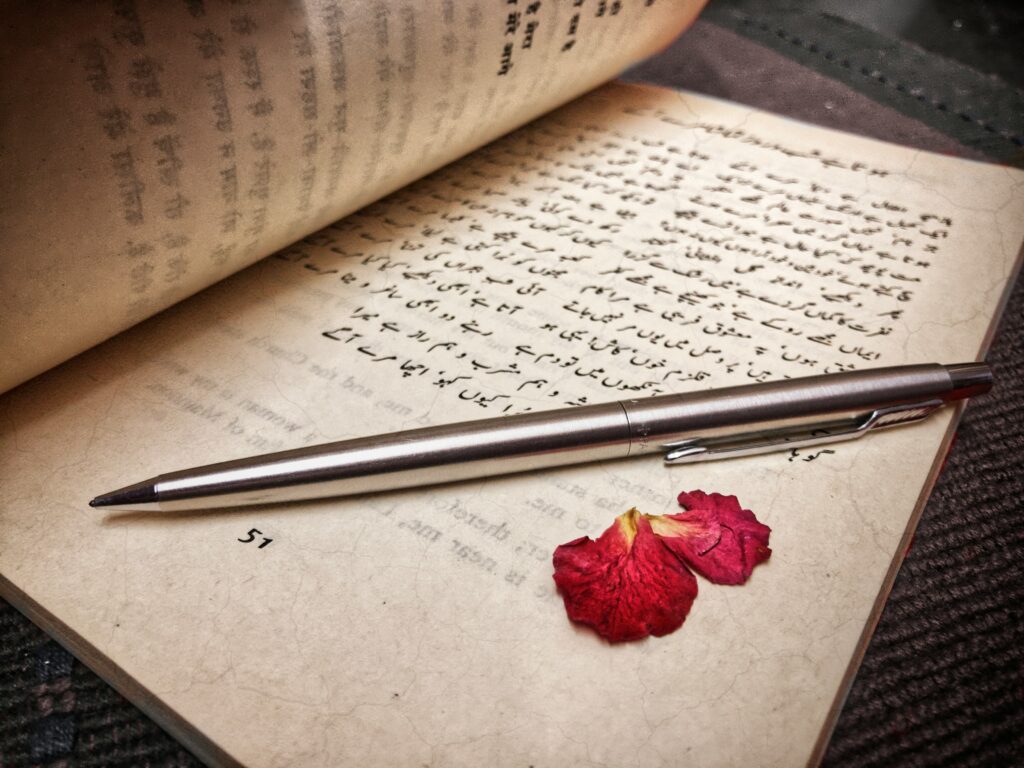A Friendly Journey Through Time- The History of Urdu Poetry and Prose

Hey there, literary lovers!
Today, let’s take a delightful stroll through the fascinating history of Urdu literature. This journey will take us from its humble beginnings to the vibrant world of poetry and prose we enjoy today.
So, grab a cup of Chaye, get comfy, and let’s dive in!
Early Beginnings: The Birth of Urdu
Urdu literature has its roots in the 15th century, emerging as a beautiful blend of Persian, Arabic, and local Indian languages during the Muslim conquests. Imagine a melting pot of cultures coming together to create something unique!
The first literary works were primarily poetry, with the earliest verses popping up in the 16th century. This was just the beginning of a rich literary tradition that would grow and evolve over the centuries.
Did you know that the name “Urdu” itself has an interesting origin story? It actually comes from the Turkish word “ordu,” which means “camp” or “army.” Pretty cool, right? This little tidbit reveals that Urdu first emerged as a common language used by soldiers and traders during the Mughal Empire in the Indian subcontinent.
Back then, people referred to it as “Hindavi” or “Rekhta,” but it wasn’t until the 18th century that the name Urdu started to stick. So, what’s the story behind this name change? Well, Urdu developed by blending together influences from Persian, Arabic, and various local Indian dialects. It was this unique linguistic fusion that gave Urdu its distinct flavor and identity.
Isn’t it amazing how a language can evolve from the needs of an army camp into a rich literary tradition that continues to captivate readers worldwide? Urdu’s origins remind us that great things can arise from humble beginnings, especially when diverse cultures come together. So, the next time you read a beautiful Urdu poem or novel, remember the fascinating journey that brought this language into being!

A Glimpse of Early Urdu Poetry
As we explore the early beginnings of Urdu literature, it’s fascinating to look at some poetry from that time. One of the notable poets from the 18th century is Syed Khwaja Mir Dard, whose work exemplifies the beauty and depth of early Urdu poetry.
Here’s a couplet from one of his ghazals:
دوستو، دیکھا تماشا یہاں کا بس
تم رہو؛ اب ہم تو اپنے گھر چلے
Dōstō, dēkhā tamāśhā yaāhan kā bas.
Tum raho; ab hum tō apne ghar chalē.
Translation:
Friends, I’ve seen the spectacle of this place enough.
You stay here; I’m heading home.
This couplet beautifully captures a sense of reflection and longing, showcasing the emotional depth that early Urdu poets were known for.
The Golden Age of Poetry: A Time of Greats
Fast forward to the 18th and 19th centuries—this is often called the golden age of Urdu poetry! During this time, we saw the rise of legendary poets like Mirza Ghalib, Allama Iqbal, and Faiz Ahmed Faiz. These literary giants introduced fresh themes and styles, exploring everything from love and philosophy to social issues.
Ghalib’s ghazals, with their emotional depth and stunning language, still resonate with readers today. It’s no wonder he’s considered a central figure in Urdu literature!
The Emergence of Prose: A New Chapter
While poetry was thriving, prose in Urdu literature took a bit longer to find its footing. It wasn’t until the 19th century that we saw significant prose works starting to emerge.
Writers like Sir Syed Ahmed Khan played a crucial role in promoting Urdu as a medium for education and social reform. Thanks to the Aligarh Movement, Urdu literature began addressing contemporary issues, paving the way for a whole new generation of writers.
Modern Urdu Literature: A Bold Transformation
The 20th century brought a whirlwind of change to Urdu literature, driven by nationalist sentiments and social change. Writers began exploring new genres, including novels and short stories. Bold voices like Saadat Hasan Manto and Ismat Chughtai challenged societal norms with their daring narratives, tackling themes of partition, identity, and gender. Their works opened up new avenues for storytelling, making Urdu literature even more dynamic and relatable.
As we moved into modern times, Urdu literature embraced new styles and ideas, reflecting the complexities of contemporary life. Today, it’s not just a significant part of Pakistan’s cultural identity; it also thrives in India and among Urdu-speaking communities around the globe.

The Shift from Poetry to Prose
For centuries, poetry reigned supreme in Urdu literature, captivating audiences with its lyrical beauty and emotional depth. However, as society evolved and new ideas began to flourish, writers started to realize that prose could also serve as a powerful medium for storytelling and expression. This shift was not just about changing forms; it was about addressing contemporary issues and reflecting the complexities of life in a rapidly changing world.
The Role of Sir Syed Ahmed Khan
One of the key figures in the emergence of Urdu prose was Sir Syed Ahmed Khan. A visionary reformer and educator, he recognized the importance of using Urdu as a language of instruction and communication. Sir Syed believed that Urdu could be a vehicle for social reform, education, and modern thought. He founded the Aligarh Movement, which aimed to promote education among Muslims in India and encouraged the use of Urdu in literary and academic circles. Through his efforts, Sir Syed not only championed the use of Urdu prose but also inspired a new generation of writers to explore various genres, including essays, short stories, and novels. His work laid the groundwork for prose to flourish in Urdu literature, making it accessible and relevant to everyday life.
The Rise of New Voices
With the groundwork laid by pioneers like Sir Syed, the late 19th and early 20th centuries saw an explosion of creativity in Urdu prose. Writers began to experiment with different styles and themes, exploring social issues, personal experiences, and cultural identity. This era introduced us to remarkable authors such as Premchand, whose novels and short stories tackled the struggles of the common man and highlighted the socio-economic challenges of the time. Premchand’s storytelling was relatable and grounded in reality, making his work resonate with readers from all walks of life. His ability to weave intricate narratives that addressed social injustices while remaining engaging and thought-provoking helped establish prose as a respected literary form in Urdu.
A Diverse Literary Landscape
As prose continued to evolve, it embraced a wide range of genres, including historical fiction, social commentary, and even humor. Writers like Ismat Chughtai and Saadat Hasan Manto pushed boundaries with their bold narratives, addressing topics such as gender, partition, and the human condition. Their works not only entertained but also sparked important conversations about society and culture. This rich tapestry of prose allowed Urdu literature to reflect the diverse experiences and voices within the community. It became a platform for exploring complex themes and emotions, making it relatable to readers and enriching the literary landscape.
Common Misconceptions About Urdu
Urdu, a language rich in history and culture, is often surrounded by various misconceptions. Here are some of the most prevalent myths that deserve clarification:
Here are some prevalent myths about Urdu that are worth clarifying:
- Urdu is a Mixed Language: Some folks think of Urdu as just a “mixed language” or a “khitchri zubaan,” but that’s not quite accurate! While it does borrow vocabulary from Persian and Arabic, Urdu has its own unique grammar and structure. Think of it like English, which has absorbed words from Latin and Greek over the years. Just because it shares some words doesn’t mean it’s any less of a distinct language!
- Urdu is Exclusively a Muslim Language: Many people believe that Urdu is only a Muslim language, but that’s a misconception! Urdu has a rich literary heritage that includes contributions from writers of various religious backgrounds, including Hindus and Sikhs. For centuries, it has served as a common cultural and literary medium for everyone in India, regardless of their faith.
- Urdu Developed Only in the 18th Century: It’s a common belief that Urdu only gained prominence in the 18th century, but that’s not the whole story! The roots of Urdu can actually be traced back to the 11th and 12th centuries. It evolved over time, influenced by local dialects and the rich socio-cultural dynamics of the region. So, it’s been part of the Indian linguistic landscape for much longer than many realize!
- Urdu is an Alien Language to India: Some might think that Urdu is foreign to India, but that couldn’t be further from the truth! Urdu is deeply woven into the cultural and historical fabric of India. It has evolved right here, drawing from the diverse linguistic heritage of the subcontinent. Many iconic literary figures, regardless of their backgrounds, have contributed to Urdu literature, showcasing its significance in Indian history.
Conclusion: Celebrating Our Literary Heritage
The history of Urdu literature is a beautiful tapestry woven from the creativity and resilience of its writers. From its poetic origins to the diverse expressions we see today, Urdu literature has continually adapted to reflect the changing social and cultural landscape.
So, whether you’re a lifelong fan of Urdu poetry or just starting to explore its rich narratives, there’s so much to appreciate. Let’s celebrate this incredible literary heritage together, as it invites us to explore its depths and revel in its beauty. Happy reading!
